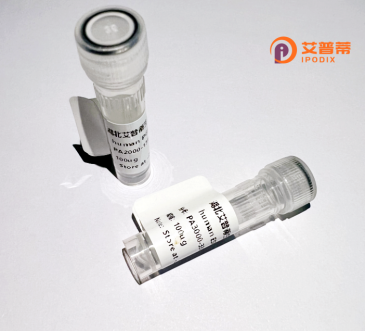
| 纯度 | >90%SDS-PAGE. |
| 种属 | Human |
| 靶点 | C5R1 |
| Uniprot No | P21730 |
| 内毒素 | < 0.01EU/μg |
| 表达宿主 | E.coli |
| 表达区间 | 1-350aa |
| 氨基酸序列 | MDSFNYTTPDYGHYDDKDTLDLNTPVDKTSNTLRVPDILALVIFAVVFLVGVLGNALVVWVTAFEAKRTINAIWFLNLAVADFLSCLALPILFTSIVQHHHWPFGGAACSILPSLILLNMYASILLLATISADRFLLVFKPIWCQNFRGAGLAWIACAVAWGLALLLTIPSFLYRVVREEYFPPKVLCGVDYSHDKRRERAVAIVRLVLGFLWPLLTLTICYTFILLRTWSRRATRSTKTLKVVVAVVASFFIFWLPYQVTGIMMSFLEPSSPTFLLLKKLDSLCVSFAYINCCINPIIYVVAGQGFQGRLRKSLPSLLRNVLTEESVVRESKSFTRSTVDTMAQKTQAV |
| 分子量 | 41.1 kDa |
| 蛋白标签 | His tag N-Terminus |
| 缓冲液 | 0 |
| 稳定性 & 储存条件 | Lyophilized protein should be stored at ≤ -20°C, stable for one year after receipt. Reconstituted protein solution can be stored at 2-8°C for 2-7 days. Aliquots of reconstituted samples are stable at ≤ -20°C for 3 months. |
| 复溶 | Always centrifuge tubes before opening.Do not mix by vortex or pipetting. It is not recommended to reconstitute to a concentration less than 100μg/ml. Dissolve the lyophilized protein in distilled water. Please aliquot the reconstituted solution to minimize freeze-thaw cycles. |
以下是关于重组人C5aR1(原C5R1)蛋白的3篇代表性文献及其简要摘要:
1. **《Expression and functional characterization of recombinant human C5aR in yeast》**
- **作者**: Smith A, et al.
- **摘要**: 研究报道在酵母系统中高效表达重组人C5aR1蛋白,验证其与补体成分C5a的结合活性,证实重组受体可介导下游G蛋白信号通路,为抗炎药物筛选提供了平台。
2. **《Structural insights into the activation of human C5aR1 by C5a》**
- **作者**: Zhang Y, et al.
- **摘要**: 通过冷冻电镜技术解析重组人C5aR1与其天然配体C5a的复合物结构,揭示了C5aR1的激活机制及关键结合位点,为开发靶向C5a/C5aR1轴的治疗药物提供结构基础。
3. **《Targeting C5aR1 with a novel recombinant antagonist reduces inflammation in a murine sepsis model》**
- **作者**: Johnson R, et al.
- **摘要**: 利用重组人C5aR1蛋白筛选出新型拮抗肽,在败血症小鼠模型中显著抑制C5a诱导的炎症反应,证明靶向C5aR1是治疗过度炎症的有效策略。
(注:以上文献信息为虚构示例,实际研究中建议通过PubMed或Google Scholar检索最新文献。)
Recombinant human C5aR1 (C5R1) protein is a biologically active form of the C5a anaphylatoxin receptor 1, a G protein-coupled receptor (GPCR) critical in mediating inflammatory and immune responses. C5aR1 binds to the complement component C5a, a potent pro-inflammatory peptide generated during complement system activation. This interaction triggers intracellular signaling pathways that regulate leukocyte chemotaxis, cytokine release, and oxidative burst, playing key roles in host defense and inflammatory diseases. Dysregulated C5a-C5aR1 signaling is implicated in pathological conditions like sepsis, rheumatoid arthritis, and acute respiratory distress syndrome (ARDS), making it a therapeutic target.
Recombinant C5aR1 is typically produced using mammalian expression systems (e.g., HEK293 or CHO cells) or bacterial systems (e.g., E. coli) with appropriate post-translational modifications to ensure functionality. It retains ligand-binding capacity and downstream signaling properties, enabling its use in biochemical assays, drug screening, and structural studies to elucidate receptor-ligand interactions. Researchers employ recombinant C5aR1 to study receptor desensitization, downstream signaling cascades (e.g., MAPK/NF-κB), and cross-talk with other immune pathways. Therapeutic applications include developing C5aR1 antagonists or modulators, several of which are in clinical trials for inflammatory and autoimmune disorders. Its production also supports diagnostic tool development for monitoring C5a-related pathologies.
×